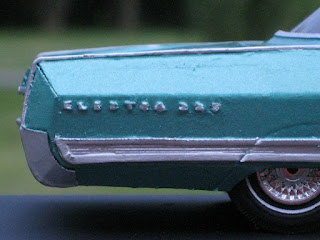Warning, picture heavy!!
Model may not be all that precise, but as far as I know, it is the only one of its kind in existence, as of this typing.
Everything is cardboard except for the plastic interior box, the acetate window "glass" and the chrome plated plastic Jo-Han 1977 Cadillac Coupe deVille wheels.
My car did not have the optional front fender cornering lamps, just above the sides of the bumper, so that is reflected in this model.
Center corner crease in the rear window was unique to the Electra coupe, in the Buick line. Oldsmobile Ninety Eight coupes also had this same rear window treatment. It was repeated in 1966.
Enjoy.The long taillights, first used here, on the 1965 Electra, would later on become a Buick hallmark for years to come. That along with the front fender "Ventiports", (portholes), which those were premiered on the 1949 Buicks.
Heavy ribbed lower body chrome plated pot metal side mouldings, which ran the total length of both sides of the car, weighed more than what most whole cars of today, do. Just kidding. This also was a styling cue of Buick Electra's made from 1963 through the 1966 model year. For '67, it was discontinued. A modernized version of this design was brought back for the 1991 through 1996 Buick Park Avenue.
Chrome block serif type capital letters spelled out "ELECTRA 225" across the rear flanks of the huge quarter panels of the car. 1965 was the last year Buick did this styling feature. In 1966, Buick went to a two piece chrome plated pot metal cursive script model name badge.
If I can make a model of this car out of cardboard, how much harder for a model manufacturer would it be to replicate this car in die cast metal, or plastic. Come on model companies!! You are missing a whole new marketing opportunity out there as alot of these big American luxury cars were never replicated as scale models, even when these cars were new. As such, they are now becoming today's collector cars.
Here is the link to my original post on this model.
http://jayveejayaresjunk.blogspot.com/2010/04/1965-buick-electra-225-coupe-125-scale.html
Just a little note that I do not do commissioned model making work. This is just a hobby of mine. If I did it for a living, it would not be enjoyable for me to do, and I would probably stop doing them.
Jim.




























